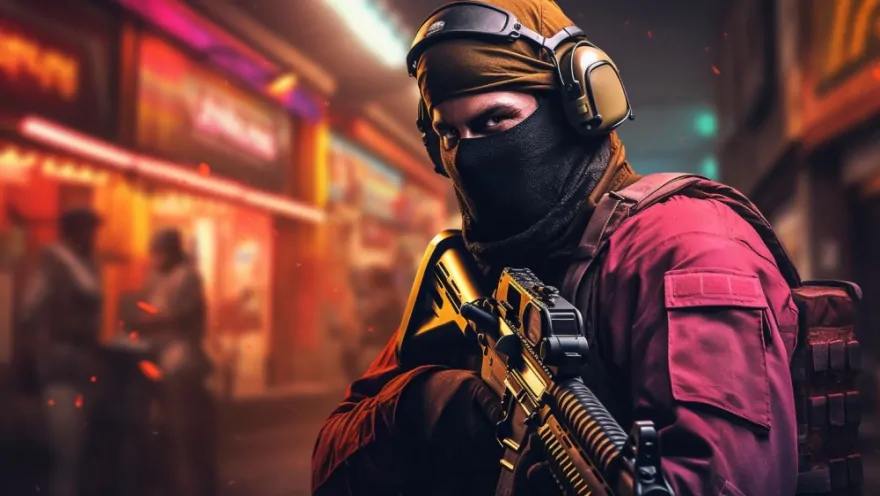A single digital file for a rifle in Counter-Strike can sell for hundreds of thousands of dollars. But who makes these virtual masterpieces? They are the digital goldsmiths, a global community of artists forging fortunes from pixels.
More Than a Paint Job: The Art and Science of a Perfect Finish
Calling a high-tier Counter-Strike skin a “paint job” is like calling a Swiss watch a “time-teller.” It misses the point entirely. The creation of a successful skin is a complex art form that exists at the intersection of graphic design, 3D modeling, and material science. A great skin isn’t just a cool illustration slapped onto a gun. It has to work with the weapon’s physical shape, with certain parts of the design highlighted during the game’s reload and inspect animations. Artists must also consider how the finish will “wear” over time. As a skin’s condition degrades from “Factory New” to “Battle-Scarred,” the design must wear away in a visually appealing and realistic manner. It requires a deep understanding of how light interacts with different virtual materials, from iridescent patterns to engraved metals, turning a simple texture file into a dynamic piece of art.
The Workshop Gauntlet: From Photoshop to Valve’s Greenlight
The path from a creative idea to an in-game item is a long and arduous gauntlet. It begins in digital art programs like Photoshop, Substance Painter, and Blender, where an artist can spend hundreds of hours perfecting their design. Once a design is complete, the artist uploads it to the Steam Workshop. This is a massive, public gallery where the entire community can view, rate, and comment on new finishes. Gaining visibility and positive votes here is a crucial first step. This model of a user-driven platform where content is submitted and curated is a powerful one. Many platforms, from social media to interactive entertainment, use similar principles to feature popular content. For a look at how another type of platform curates its offerings, one can check out this website. For the skin creator, however, the Workshop isn’t just a gallery; it’s a democratic and brutal arena. A great design with community backing has a chance to catch Valve’s eye. A bad one sinks without a trace.
The Six-Figure Payday: The Economics of a ‘Covert’ Skin
The odds are astronomical. Hundreds of new skins are submitted to the Workshop every week. Valve, the developer of Counter-Strike, selects only a tiny handful-maybe 15-20 skins every few months-to be included in a new official weapon case. But if an artist’s design is chosen, the reward can be life-changing. It’s a lottery ticket that rewards immense skill. When a skin is included in a case, the creator is entitled to a portion of the revenue generated from the sale of the keys used to open that case. While Valve has never publicly disclosed the exact percentage, it is widely understood that a single, popular skin in a successful case can generate a six-figure, or in some cases even a seven-figure, payday for its creator. This has turned a passionate hobby into a viable and potentially incredibly lucrative career, a true creator economy built on pure artistic and technical merit.
A Canvas of Constraints: Designing for Wear, Rarity, and 3D Space
The artistic challenge of creating a skin is unique. Unlike a traditional painting, the canvas is a complex, three-dimensional object that is constantly in motion. The artist must consider every angle, every curve, and how the design will look from the player’s first-person perspective. But the constraints go even deeper. They must design for the “wear” system, creating textures that look good when they are pristine (“Factory New”) and when they are heavily damaged (“Battle-Scarred”). Some artists even design procedural finishes, like the legendary “Case Hardened” skin, where a large, colorful pattern is applied to the weapon. This means that no two Case Hardened skins are exactly alike. This creates an entire sub-economy of rarity, where a specific pattern-like a mostly blue “blue gem”-can be thousands of times more valuable than a standard one. The artist isn’t just creating a design; they are creating a system of rarity.
Beyond the Individual: The Rise of Creator Collaborations and Studios
With the skin market becoming mature, and the competition getting more competitive, the image of the lone artist working in his/her bedroom has begun to be altered. The society is changing. What is happening now is the emergence of collaborations and small and informal studios. Complementary artists will join forces. A great 2D artist could team up with a 3D texturing-master to produce a more completed, more sophisticated finished product. Such collaborations enable creators to pursue bolder designs and have a better opportunity of being noticed in the busy Workshop. They divide the labor, combine their creative ideas and in the event of their skin being selected, there is the reward to share. It is an indication that the community is becoming more professional and is assuming a more corporate attitude to what used to be a purely interest based hobby. It is only the logical development of an emerging digital arts culture.
Conclusion: The Unsung Artists of the Digital Age
One of the most interesting economies in the digital world is the multi-billion dollar Counter-Strike skin market. And in the middle of it the digital goldsmiths. The hundreds of thousands of unnamed artists whose lives are dedicated to making stunning, detailed works of art to grace a canvas that does not even exist outside of a video game. They are not plain decorators; they are good technicians, community managers and entrepreneurs. They are a demonstration of what a real creator economy can do in that vast value can be created on a pure-talent basis and then democratically shared on a community-based platform. The next time, you encounter a legendary skin in the game, keep in mind that it was not created by an algorithm. It was tediously created by an artist, a digital era unsung hero.
